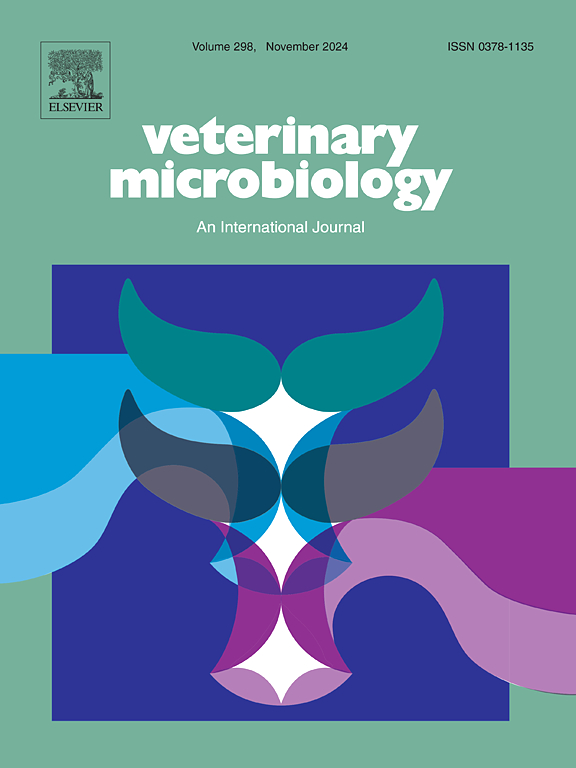核心基因组多位点序列分型揭示了芬兰狐狸、牛和猪场常见的地方性肠炎沙门氏菌感染
IF 2.7
2区 农林科学
Q3 MICROBIOLOGY
引用次数: 0
摘要
2002年,芬兰的狐狸养殖场开始出现肠炎沙门氏菌感染,但直到2014年,牛场和猪场才出现肠炎沙门氏菌感染。肠炎沙门氏菌也是全国各地死刺猬中常见的发现。本研究采用核心基因组多位点序列分型(cgMLST)研究肠炎沙门氏菌感染的流行病学。我们分析了2014年至2022年从动物身上收集的147株分离株,以及2002年收集的2株分离株。所有来自狐狸和猪场的分离株以及86% %来自牛场的分离株聚集在一起,表明2014-2020年期间感染呈弥散性和逐渐传播。2021年,在狐狸养殖场爆发了肠炎沙门氏菌,随后在2022年狐狸养殖区的养牛场病例增加。狐狸中的疫情是由一种地方性毒株引起的,该毒株在2021年广泛传播之前一直在动物单位内传播。这些结果提示狐养殖地区存在地方性肠炎沙门氏菌感染。这种感染最有可能通过啮齿动物和鸟类等害虫从受感染的狐狸养殖场传播到牛和猪养殖场。为了防止感染的传播,应在养狐中实施更好的生物安全措施和改善生产卫生。从刺猬身上分离出来的分离物在遗传上与从其他动物身上分离出来的分离物不同。它们是高度均匀的,形成了自己的cgMLST簇。根据经典MLST,所有芬兰分离株,包括来自刺猬的分离株,都属于ST11。本文章由计算机程序翻译,如有差异,请以英文原文为准。
Core genome multilocus sequence typing reveals an endemic Salmonella Enteritidis infection common to fox, cattle, and swine farms in Finland
Salmonella Enteritidis infections started to appear in fox farms in Finland in 2002, but it was not until 2014 when S. Enteritidis emerged on cattle and swine farms. S. Enteritidis is also a common finding from dead hedgehogs throughout the country. In this study, we used core genome multilocus sequence typing (cgMLST) to investigate the epidemiology of S. Enteritidis infection. We analyzed 147 isolates collected from animals between 2014 and 2022, as well as two isolates from 2002. All isolates from fox and swine farms and 86 % of those from cattle farms clustered together, suggesting a diffuse and gradual spread of the infection during 2014–2020. In 2021, an outbreak of S. Enteritidis occurred on fox farms, followed by an increase in cases on cattle farms in the fox farming region in 2022. The outbreak in foxes was caused by an endemic strain that had been circulating within animal units before spreading widely in 2021. These findings suggest an endemic S. Enteritidis infection in the fox farming area. The infection is most likely transmitted from infected fox farms to cattle and swine farms via pests, such as rodents and birds. To prevent the spread of infection, better biosecurity measures and improved production hygiene should be implemented in fox farming. Isolates from hedgehogs were genetically distinct from those obtained from other animals. They were highly homogeneous and formed their own cgMLST cluster. All the Finnish isolates, including those from hedgehogs, belonged to ST11 according to classic MLST.
求助全文
通过发布文献求助,成功后即可免费获取论文全文。
去求助
来源期刊

Veterinary microbiology
农林科学-兽医学
CiteScore
5.90
自引率
6.10%
发文量
221
审稿时长
52 days
期刊介绍:
Veterinary Microbiology is concerned with microbial (bacterial, fungal, viral) diseases of domesticated vertebrate animals (livestock, companion animals, fur-bearing animals, game, poultry, fish) that supply food, other useful products or companionship. In addition, Microbial diseases of wild animals living in captivity, or as members of the feral fauna will also be considered if the infections are of interest because of their interrelation with humans (zoonoses) and/or domestic animals. Studies of antimicrobial resistance are also included, provided that the results represent a substantial advance in knowledge. Authors are strongly encouraged to read - prior to submission - the Editorials (''Scope or cope'' and ''Scope or cope II'') published previously in the journal. The Editors reserve the right to suggest submission to another journal for those papers which they feel would be more appropriate for consideration by that journal.
Original research papers of high quality and novelty on aspects of control, host response, molecular biology, pathogenesis, prevention, and treatment of microbial diseases of animals are published. Papers dealing primarily with immunology, epidemiology, molecular biology and antiviral or microbial agents will only be considered if they demonstrate a clear impact on a disease. Papers focusing solely on diagnostic techniques (such as another PCR protocol or ELISA) will not be published - focus should be on a microorganism and not on a particular technique. Papers only reporting microbial sequences, transcriptomics data, or proteomics data will not be considered unless the results represent a substantial advance in knowledge.
Drug trial papers will be considered if they have general application or significance. Papers on the identification of microorganisms will also be considered, but detailed taxonomic studies do not fall within the scope of the journal. Case reports will not be published, unless they have general application or contain novel aspects. Papers of geographically limited interest, which repeat what had been established elsewhere will not be considered. The readership of the journal is global.
 求助内容:
求助内容: 应助结果提醒方式:
应助结果提醒方式:


